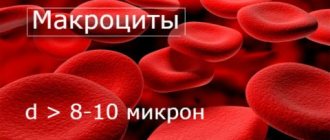Definition
Toxic granularity of neutrophils refers to changes that are always associated with the process of human toxicosis. The pathology received this name because it was first identified in patients suffering from sepsis caused by gram-negative microorganisms. But this does not mean that such organisms have a toxic effect on neutrophils.
When we talk about such a condition, as a rule, we mean special disturbances in the morphological structure of cells, subject to stimulation of the acceleration of their maturation and occurrence in the bone marrow. Such a disorder reflects desynchronization of the maturation processes of the cytoplasm and nucleus of blood cells.
With these pathological changes in leukocytes, specific inclusions and large granules are formed in the cytoplasm of the cell. This disorder develops due to changes in the structure of proteins. The formation of specific vacuoles and Dele bodies is also possible.
What will the blood test say?
Using a special blood test, you can determine how severe the changes have affected the patient’s neutrophils. There is a special classification for this. To indicate severity, the usual plus signs are used - depending on their number, the severity is assessed. The severity is determined by how large the granules are formed in the cytoplasm, as well as by the percentage of diseased, pathologically altered cells from the total number.
- Fine dust-like granularity is considered a minor pathology and is indicated by one plus +.
- Two pluses ++ are given when the granularity is classified as medium and, on average, pathologically altered cells make up approximately half of the total number.
- Three pluses +++ - 75% of diseased cells, serious changes, large granules.
- Four pluses ++++ are given when blood cells are seriously affected, their number tends to one hundred percent, and general changes are a serious threat to the patient’s life.
In addition to the general quantitative indicator, the following changes are sometimes displayed using pluses in the analysis results:
- Type of grain, its presence and severity.
- The presence of Dele structures, which can have variable sizes and shapes. It may also be noted if they are colored light blue, which is also a diagnostic symptom.
- Vacuolization of cell plasma, which, however, is a very serious symptom and certainly does not go unnoticed. As a rule, such changes can be observed in the case of sepsis, leukocytosis and other similar diseases. The combination of this and other pathologies in combination is considered especially dangerous.
- Hypersegmentation of the nucleus, when it is divided into many sections. Five or more segments are considered dangerous. In very rare cases, this is not a symptom of a disease and is considered a physiological feature of a healthy person. This feature is inherited and is a harmless genetic change.
Causes of toxic granularity of neutrophils
Experts identify the occurrence of this disease due to:
- Radiation damage to the body.
- Cancerous formations that are at the stage of decay.
- Pathologies that are accompanied by a strong deterioration in the general condition of the patient.
- Phenomena of inflammatory nature and purulent nature.
In addition, changes in neutrophils may occur in the following conditions:
- The appearance of a resolving infiltrate.
- Phlegmon.
- Peritonitis.
- Lobar pneumonia.
Phagocytic activity of neutrophils
is the cell's ability to absorb
, microbes, parts of other cells. The main function of neutrophils is to protect the body from pathogenic agents. It is these cells that meet pathogenic agents that enter the body first.
The phagocytic activity of these cells increases in the first stages of inflammation. If it decreases, inflammation progresses to the chronic stage, and there is a possibility of developing autoimmune processes.
Manifestations in children
If a child has toxic granularity of neutrophils, then, as a rule, it is a consequence of a recent illness, accompanied by a strong increase in temperature, chills, prolonged high fever, and the release of large amounts of pus. Among these pathologies:
- Skin diseases accompanied by a pronounced process of separation of pus (for example, phlegmon).
- All diseases that are included in the “acute abdomen” group.
- Pathologies that began suddenly in the abdominal cavity.
- Scarlet fever, measles.
What other reasons could there be for toxic granularity of neutrophils in a child?
In some cases, pathology in children manifests itself as Chediak-Higashi syndrome. This condition is a congenital and very rare disorder in which all leukocyte cells are affected. In such children, severe immune deficiency first occurs.
In addition, children are often susceptible to pustular and infectious pathologies and are highly prone to malignant hemorrhages. Unfortunately, this disease often has a poor prognosis.
Diagnostics
Toxic granularity cannot always be detected with conventional staining, so special methods are used to identify it, namely the Freifeld staining method. In this case, fuchsin and a solution of methylene blue are used.
To prepare the first dye, one gram of fuchsin is placed in 96% ethyl alcohol (15 grams) and heated until dissolved. After it has cooled, add a 5% solution of carbolic acid in an amount of 100 ml. Seven drops of the first dye are added to 20 ml of water and mixed, then the second dye (1% methylene blue solution) is added in an amount of five drops and mixed again. Blood smears are painted with the prepared mixture for an hour, after which they are washed off with water and dried. If Romanovsky staining was previously performed, the Freifeld method can be used without prior bleaching.
After staining, lilac granularity can be observed in the form of dust or flakes, which depends on the severity of the disease. As a result of the analysis, the size of the granules is usually indicated, that is, the granularity can be dusty, fine, medium, large, in the form of flakes, and the number of neutrophils (per hundred cells) with toxogenic granularity as a percentage.
In addition, when diagnosing you need:
- calculate the leukocyte formula;
- identify the total number of leukocytes;
- determine whether leukocytes have pathological changes;
- determine the level of young forms of neutrophils.
Indicators of normal cellular structures
The normal level of toxic granularity is considered to be 0%. But there are also conditional indicators when the content of abnormal cells is insignificant, and medical supervision is not required. These conditions include:
- Pregnancy.
- The recovery period after an infection.
- Postoperative period.
It is important to remember that even a slight excess of the normal value indicates the presence of a pathological process in the body. During therapy, the specialist monitors the number of abnormal cells in order to assess the effectiveness of the prescribed treatment and its possible adjustment.
Neutrophils in the body and in the blood
Mature cells of this type in human blood should be present from 47 to 72% of all leukocytes and up to 5% of immature cells. Immature cells are distinguished by the fact that their nucleus is elongated, resembles a rod, and is not divided into segments.
These cells are formed in the red bone marrow. Only one percent of neutrophils are present in the blood, 60% remains in the bone marrow and 40% in other internal organs.
Only mature cells with a segmented nucleus penetrate into the blood; they remain here for only a short time, after which they enter other organs. The duration of the life cycle of these cells depends on whether there is an inflammatory process in the body.
In an adult healthy person, the norm of these cells ranges from 1800000000 to 6500000000 liters.
Types of changes
This pathology can be detected by staining smears in the usual way. However, even with high-quality painting, dusty toxogenic granules may not be visible. Therefore, special methods have been proposed to identify the disease, of which the Freifeld method is the most common and accessible.
A special classification is used to characterize the severity of toxic granularity of neutrophils. Doctors have developed a so-called plus system for this. When classifying lesions, the granules that have formed in the affected cells are assessed, as well as the percentage of diseased cells:
- Grit +. In this case, small grains are detected.
- Grit ++. It is diagnosed when it is of medium size, and about half of all cells are pathological.
- Grit +++. Damage to about 75% of all cells was noted, in which large-sized altered grains were found.
- Grit ++++. There is a pathology of blood cells that is life-threatening. The cytoplasm in this case is sparse and contains large granules.
Reasons for appearance
The main causes of toxic neutrophil granularity include:
- bacterial, severe viral infections and inflammatory processes;
- immunodeficiency states;
- severe purulent-septic processes and all septic diseases;
- diseases leading to impaired hematopoiesis;
- exposure to toxic substances and chemicals;
- effects of radioactive radiation, including therapeutic ones.
The degenerative granularity of neutrophils is especially pronounced during scarlet fever, lobar pneumonia, purulent-septic diseases: with peritonitis, phlegmon, septicopyemia, as well as in the process of resorption of infiltrates and the disintegration of malignant tumors.
Important! Morphological changes in the cytoplasm and the appearance of toxogenic granulation are not always caused by the toxic effects of microorganisms. They may be caused by increased neutrophil production and shortened neutrophil maturation times, which are not caused by pathogens.
For example, toxigenic granulation can occur in pregnant women, but both the woman and the fetus will be absolutely healthy.
It should also be noted that the appearance of toxic granularity in neutrophils can be caused by infectious and inflammatory diseases that cause a drop in the level of neutrophils in the blood and require treatment with colony-stimulating drugs.
Tests required to detect graininess
The most important study to clarify the diagnosis is the analysis of changes in the leukocyte series. This study is very significant for differentiating diseases. For example, any pathological changes in the lungs cause a neutrophil shift to the left, while changes in the oncological nature do not cause degenerative granulation. Any inflammatory processes, on the contrary, always cause such a state of cells.
To detect toxic granularity of neutrophils in a child and an adult, a special laboratory test of a blood sample is performed using methylene blue and fuchsin. The latter is prepared as follows:
- By heating one gram of dye is dissolved in 15 grams of 96% ethanol.
- After this, a 5% solution of carbolic acid in an amount of 100 grams is added to the resulting mixture.
- Then 7 drops of the resulting staining solution and 1% methylene blue in an amount of 5 drops are added to 20 ml of water. The resulting solution is thoroughly diluted, then the smears are stained with it for one hour. After this, they are washed off and dried. This method allows you to examine granularity (flakes, dust) under a microscope.
Diagnostics of toxic and toxogenic granules in laboratory conditions
Usually, in order to identify such pathologies, the leukocyte formula is calculated in the laboratory. In textbooks and manuals you can find a description of the method under the name “Romanovsky staining method.” Intense, pronounced granularity appears in neutrophils and is clearly visible if present. Such granularity is not typical for healthy cells. The graininess in the form of spraying over the entire plane should be especially alarming. A blood test uses a smear. To accurately determine the type of grain, the Freifeld staining method is used. This method uses fuchsin and methylene blue. The result of the analysis should indicate not only the presence or absence of granulation, but also various distinctive features. For example, the massiveness of individual granules, uniformity, dustiness. A percentage is used to display the stage of the disease.
Symptoms and consequences
If the normal levels of toxic granularity are exceeded, the human body begins to respond to disease processes with certain complex reactions.
Most often, pronounced toxic granularity of neutrophils is a symptom of the development of a pathology in which there is an increase in the number of granulocytes in the blood. This may also indicate a shift in the leukocyte formula to the left.
With the growth of degrading neutrophils, the patient begins to develop bacteremia and generalization of the infectious process occurs. If the number of neutrophils with pathological changes exceeds 50% in septic or purulent diseases, or this indicator increases, then the prognosis becomes unfavorable.
The patient exhibits symptoms of the disease that caused the disorder - lobar pneumonia, radiation poisoning, etc. Chills and toxic granularity of neutrophils often accompany each other.
The doctor must take into account the dynamics of changes in the patient’s blood parameters, adjust treatment if necessary, and prescribe certain medications. A rapid increase in neutrophil concentration is not a good sign.
Therapy for toxic granulation directly depends on the success of treatment of the underlying pathology that provoked changes in blood cells, since toxigenic changes are nothing more than its consequences. In this case, the doctor can only monitor the leukocyte formula.
Norm and deviations
In healthy people, there is no toxic granularity in the blood. A small number of grains may appear in the analysis in pregnant women. If the patient feels well, a repeat test is prescribed after some time. The presence of a small number of granules is normal and does not require treatment.
Important information: What is hematocrit in a blood test and the norm for women by age (table)
In children after infectious diseases, this index may be present in the analysis. This is due to weak immunity. After a few weeks, the test result returns to normal. Grains may appear after surgery.
If toxic granularity occurs, the specialist recommends regularly testing the blood to monitor the dynamics of changes. If the index increases, this indicates the development of the disease and generalization of the infection, which is a poor prognosis. If the indicator decreases, this shows positive changes in the patient's body.











